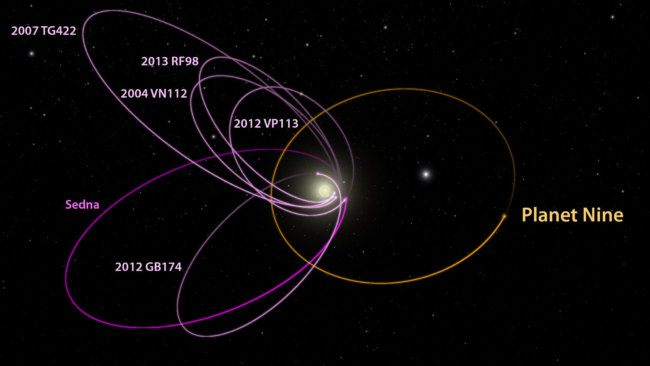
In January 2016, astronomers Mike brown and Konstantin Batygin has published the first indirect evidence of the existence of another planet within the Solar system. Body, which received the unofficial title of “the Ninth planet”, is a hypothetical object, whose orbit, according to scientists, lies extremely far away from our Sun. Since the publication of brown and batygina other astronomers have conducted one study and tried to answer the most important question – how could this Ninth planet?
While some studies suggest that the planet has been pushed to the edge of the Solar system after its formation, while others believe that the object may be an exoplanet, attracted to our Solar system at some period of its history. However, recent research astronomers casts serious doubt on the latter and suggests that the Ninth planet was most likely formed much closer to the Sun than it is now, and then in the course of history migrated to the outer boundaries of the system.
A team of specialists under the direction of Dr. Richard Parker of the Department of physics and astronomy at the University of Sheffield conducted the study together with colleagues from ETH Zurich. The results of the research of the astronomers was published in the journal Monthly Notices of the Royal Astronomical Society (“Monthly notes of the Royal astronomical society”).

Six of the most distant known objects in the Solar system located beyond the orbit of Neptune and mysteriously arranged in the same direction. Diagram created using the program WorldWide Telescope
The question of the existence of the Ninth planet (or “Planet X” for those who still believes Pluto is a planet) was first staged in 2014 astronomers Chadwick Trujillo and Scott Sheppard on the basis of the unusual behavior of certain clusters of extremely remote TRANS-Neptunian objects (TNO). From a number of studies conducted in subsequent years, scientists have been able to establish the basic parameters of the object, which could cause this behavior.
At some point, it was concluded that the Ninth planet may be at least 10 times more massive than Earth and about two to four times bigger than our planet. There is also a view that it has a very large elliptical orbit around the Sun with an average distance to the star is roughly 700 astronomical units (a. E.). While its perihelion (closest distance to the star) amounts to about 200. E., and the aphelion (farthest point of the object location from the star) about 1200. E. Scientists estimate that in this case, a full rotation around the Sun have the Ninth planet can take from 10 000 to 20 000 years.
Based on these data, scientists doubted that the Ninth planet could have formed in its current location. That is why among astronomers there was a dispute about whether the planet formed closer to the Sun, and then migrated to the outer boundaries of the Solar system, or was she drawn our system from another system several billion years ago.
“We know that planetary systems began to emerge simultaneously with the emergence of the first stars. Young stars are very often in groups, where interaction between stellar objects is a common occurrence. The environment where the formation of new stars, can directly affect the planetary system. The system can be located very close to each other, so stars one system can attract stars or planets of other systems,” said Dr. Parker in a press release the University of Sheffield.
For the study, a team of astronomers conducted a computer simulation of the Solar system when it was still in its “baby phase”, that is, when they happen early in the process of its formation. Despite the fact that interaction with other star systems (and their planets) in this period of time is considered by scientists common, the team came to the conclusion that even where all the conditions were optimal for catching the wandering planets, the capture probability of the Ninth planet of our system was extremely low.
In General, the simulations showed that among the objects with this orbit, as in the hypothetical Ninth planet, only 5 to 10 out of 10,000 planets could be caught and pulled the Solar system, when she was still young. According to the obtained models, the probability that the Ninth planet was pulled in to our system is 1 of 1000 or 2000.
“In this work we have shown that, despite the frequent occurrence of such a seizure similar to from the Ninth planet to happen, most likely, could not. We do not exclude the possibility of the existence of the planet itself, but we believe that it is likely, were formed near the Sun and not be pulled from another planetary system,” says Dr. Parker.
If the Ninth planet was not far-fetched in our system, it remains only one possibility: it was formed within the system, lying closer to the Sun, and then, after some time moved beyond the orbit of Neptune, sitting there, with some of the most distant objects in the Kuiper Belt.
The hunt for the “unseen” and mysterious planet continues, any study that adds new data to describe its characteristics and nature, will be extremely useful in the actual detection. Excluding one by one the likely scenarios of its formation, scientists also create new questions about the history and evolution of our Solar system that require to find answers. How did all the planets of our system? They appeared on the same orbits, where they are, or moved there? The closer we get to the Ninth planet, the more such questions will arise.
Hypothetical “Ninth planet” continues to torment the minds of astronomers
Nikolai Khizhnyak